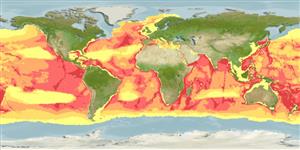Common names from other countries
Environment: milieu / climate zone / depth range / distribution range
Ecologia
Pelágico(a,os,as); oceanódromos (Ref. 75906); intervalo de profundidade 0 - 2332 m (Ref. 116169). Tropical; 90°N - 90°S, 180°W - 180°E
Atlantic Ocean, Mediterranean and Indo-Pacific. Tropical to warm temperate.
Length at first maturity / Tamanho / Peso / Idade
Maturity: Lm ?, range 366 - 427 cm Max length : 600 cm TL macho/indeterminado; (Ref. 1394); 500 cm TL (female); Peso máx. publicado: 2.0 t (Ref. 1394)
Found in shallow inshore (Ref. 122680) and deep offshore waters (Refs. 1394, 118705). Typically in groups of 10 to 60 individuals (Ref. 801). Food sharing is observed in this species, and they travel in a broad band up to several kilometers wide in order to increase success of finding prey (Ref. 122680). Feeds primarily on fish like mahi mahi and yellowfin tuna (Ref. 122680) and cephalopods (Refs. 801, 1394, 118705); was reported to attack small cetaceans and, on one occasion, even a humpback whale (Ref. 1394).
Life cycle and mating behavior
Maturidade | Reprodução | Desova | Ovos | Fecundidade | Larvas
Breeding occurs throughout the year (Ref. 97351).
Tan, J.M.L. 1995. (Ref. 936)
Status na Lista Vermelha da IUCN (Ref. 130435)
Status no CITES (Ref. 108899)
Not Evaluated
Uso pelos humanos
Pescarias: espécies comerciais
FAO - pescarias: landings, perfil da espécie | FishSource | Sea Around Us
Ferramentas
Fontes da internet
Estimates based on models
Preferred temperature
(Ref.
115969): 2.3 - 5.8, mean 3.4 (based on 3246 cells).
Vulnerabilidade
Very high vulnerability (85 of 100).
Categoria de preço
Unknown.
